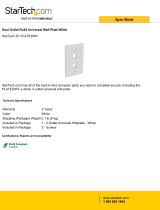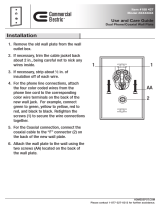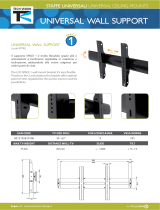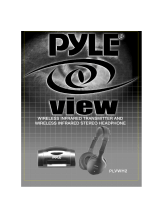Listen Technologies Stationary IR System Design Owner's manual
- Category
- Wall transmitters
- Type
- Owner's manual
This manual is also suitable for



Dear Valued Customer,
Thank you for choosing Listen! All of us at Listen are dedicated to provide you
with the highest quality products available. We take great pride in their
outstanding performance because we care that you are completely
satisfi ed. That’s why we independently certify them to the highest quality
standards and back them with a limited lifetime guarantee. We stand ready
to answer any questions you might have during installation or in the operation
of our products. Should you experience any problems whatsoever with your
Listen products, we are ready to help you in any way we can with prompt,
effi cient customer care. Because at Listen, it’s all about you! And should you
have any comments on how we might improve our products or our
service, we’re here to listen.
Here’s how to reach us:
+1.801.233.8992
+1.800.330.0891 North America
+1.801.233.8995 Fax
www.listentech.com
Thank you and enjoy your listening experience!
Best regards,
Russell Gentner and the Listen Team
• In the few instances where repairs were needed, 99% of all clients indicated that they were happy
with repair turn-around-times and 85% of the time, clients were without their product for less than
10 days!
• Overall client satisfaction of working with Listen was rated 4.8 out of 5.
• “ Please continue with your excellent attitude toward customer satisfaction. You guys are great!”
• “I’ve never had such good service from any company. Keep up the good work!”
• “You stand behind your product wonderfully.”
Assistive Listening • Language Interpretation • Soundfi eld • Tour Group • Conferencing


LR-42/44
Design Guide
LT-82
LA-140
LR-42/44 LA-350/351
Supplementary
Design Guide
LT-82
LA-140
Supplementary
LR-42/44
LA-350/351
Design Guide
Infrared Technology Overview 5
System Overview 6
Designing a System 9
Design Tools 21
LT-82 Stationary IR Transmitter
Specifi cations 35
Block Diagram 36
Quick Reference Page 37
Setup and Operating Instructions 38
Accessories for LT-82 43
LA-140 IR Radiator
Specifi cations 53
Quick Reference Page 54
Setup Instructions 55
LED Indications 57
Mounting your Radiator 58
Accessories for LA-140 78
LR-42/LR-44 4-Channel IR Receivers
Specifi cations 87
LR-42 Quick Reference Page 89
LR-44 Quick Reference Page 90
Setup Instructions 91
Operating Instructions 95
Locking Instructions 101
Programming Instructions 102
Programming Examples 107
Programmable Features Detailed Descriptions 110
Battery Charging Information 111
Accessories for LR-42/LR-44 115
LA-350/LA-351 8-Unit IR Receiver Storage/Charging Cases
LA-350 Specifi cations and Features 123
LA-351 Specifi cations and Feature 124
LA-350 Charging Requirements/Instructions 125
Cord Tidy Rack 128
Supplementary Information
Troubleshooting 137
Frequently Asked Questions 139
Compliance Information 141
Warranty 141
Contacting Listen 141
Stationary Infrared Table of Contents



Design Guide
Design Guide
Stationary Infrared Design Guide Table of Contents
Infrared Technology Overview 5
System Overview 6
Designing a System 9
Design Tools 21

Design Guide
Design Guide
Design Guide

5
Design Guide
Design Guide
Infrared Technology Overview
Infrared or “IR” technology uses infrared light to transmit audio without wires. This type of transmission is
advantageous to RF transmission because it is secure, it is not susceptible to RF interference, and one receiver
can be used for multiple rooms within a facility. The transmitter accepts an audio signal and then frequency
modulates an RF carrier at 2.3, 2.8, 3.3 and/or 3.8MHz. This carrier along with DC power (to power the
radiator) is supplied to the radiator via cables. The carriers are then radiated into the room using IR emitter
diodes. This is the same technology used by the remote control of your TV set. A receiver then receives the IR
light and demodulates the carrier.
1
23
4
Audio Source
IR Transmitter
Radiator
Receiver
When designing an IR system it is important to keep the following in mind:
• In open space (when there are no refl ective surfaces) IR is line of sight. If the receiver cannot “see” light
from the radiator, it will not receive the audio signal. It is important to provide suffi cient IR coverage within
a facility so users will not have drop outs of the IR signal. This design guide will help you do this.
• In facilities that have refl ective and lighter colored surfaces, the IR light will be refl ected and you can
achieve greater coverage. For example, when emitting in a very large room (like an exhibit hall) you will
notice that you need to point the receiver directly at the radiator to pick up the signal. However, when
the radiator is placed in a smaller room (for example 50 ft
2
/14.6 m
2
square) with white walls you will
experience much better coverage. This is because the IR signal is being refl ected in many different
directions, increasing coverage.
• Listen systems use higher modulation frequencies that make the system less susceptible to light
interference from fl uorescent lights and other sources. However, the system is not immune from
interference from sources that create IR light such as sunlight and plasma displays.
• Listen products are compatible with other manufacturers who use the same modulation frequencies
(2.3, 2.8, 3.3, 3.8 MHz).

6
Design Guide
Design Guide
Design Guide
System Overview
There are three main components of any Stationary IR system: the transmitter, radiator (emitter) and receiv-
ers.
A single channel system consists of one LT-82 transmitter and one or more radiators. The diagram below shows
such a system with one radiator. The radiator is powered from the power supply at the transmitter. This power
supply can supply enough power for the LT-82 and up to two LA-140 radiators. If you need more than two
radiators, you will need more power supplies. This is discussed later in this document. Power is supplied from
standard CAT-5 cable while RF from the transmitter is delivered using 50-ohm RG-58 coaxial cable. The radiator
is supplied with 25 feet (7.6 meters) of CAT-5 and RG-58 coaxial cable.
Single Channel System
LT-82 Stationary IR Transmitter
Mounting hardware for
radiator included with
radiator
RF – RG-58 50 ohm Cable
LR-42 IR Stetho Receiver
LR-44 IR Lanyard Receiver
Power – CAT-5 Cable
LA-140 IR Radiator
IR
1
23
4
1
23
4
1
23
4
LT-82 Transmitter
LA-140 Radiator
LR-42 LR-44
1
23
4

7
Design Guide
Design Guide
Design Guide
System Overview
A multiple channel system consists of two to four LT-82 transmitters and one or more radiators. The diagram
below shows such a system with two radiators. The radiators are powered from the power supply from the fi rst
transmitter. This power supply can supply enough power for the LT-82 and two LA-140 radiators. If you need
more than two radiators, you can use the power from the other transmitters. In this example, the four
transmitter power supplies can supply enough power for up to eight LA-140 radiators. This is discussed later in
this document. Power issupplied from standard CAT-5 cable while RF from the transmitter is delivered using
50-ohm RG-58 coaxial cable. Each radiator is supplied with 25 feet (7.6 meters) of CAT-5 and RG-58 coaxial
cable.
Multiple Channel System
Up to four LT-82 transmitters can
be daisy chained together (using
RG-58 cable) to create a
multi-channel system
LA -89 RG-58 Multi-carrier
Interconnection Cable (included)
RF – RG-58 50 ohm Cable
RF – RG-58 50 ohm Cable
Up to 100 LA-140 radiators can be daisy chained
together (using RG-58 cable) to provide sucient
IR power for most applications
LR-42 IR Stetho Receiver
LR-44 IR Lanyard Receiver
Radiator Power: Radiators can be
powered from the LT-82 (up to two
radiators) or an additional power supply
(LA-205) can power up to two radiators
Radiator RF: RF from the last LT-82 must be
daisy chained from radiator to radiator
Power – CAT-5 Cable
Power – CAT-5 Cable
LA-140 IR Radiator
LA-140 IR Radiator
IR
IR
LT-82 Stationary IR Transmitter
LT-82 Stationary IR Transmitter
LT-82 Stationary IR Transmitter
LT-82 Stationary IR Transmitter
1
23
4
1
23
4

8
Design Guide
Design Guide
Design Guide
System Overview
Each LT-82 transmitter used can power up to two LA-140 radiators. If you design a system that requires more
radiators than the transmitters can power, you need to order additional LA-205 power supplies. Each LA-205
can power up to two LA-140 Radiators.
Key Concepts of Designing a Stationary IR System
1
Each LT-82 transmitter used can power two LA-140 radiators
Up to four LT-82 transmitters can be interconnected to create up to a four channel system. For the system,
there are two RF outputs provided for connection to the radiators. Each of these two outputs is referred to as
the “Radiator Daisy Chain.” RG-58 coaxial cable is used to interconnect the RF in the radiator daisy chain. You
can connect as many radiators in the daisy chain as you need.
2
Up to four LT-82 transmitters can be interconnected to create up to a four channel system
Each radiator requires one RF (RG-58 coax) connection and one power (CAT-5) connection. The RF
connection can come from a transmitter or from another radiator. The power connection can come from
either a transmitter, a radiator or from a power supply (as long as you don’t exceed the capacity).
3
Each radiator requires one RF (RG-58 coax) connection and one power (CAT-5) connection
To make it easy for you to design, specify and install a system, Listen has provided mounting hardware for
most mounting situations including wall, ceiling, corner, desk, tripod and mic stands. To double the radiation
power you can vertically or horizontally mount two radiators together using the LA-342 dual radiator mounting
brackets. This includes coaxial RF and CAT-5 power cables.
4
Listen has provided mounting hardware for most LA-140 mounting situations
Due to the higher modulation frequencies, it is possible that the RF signal arrives to different radiators at
different times. This delay can cause the IR carriers to add “out of phase” and cause the signal to drop
out. To solve this problem, Listen has provided a delay compensation adjustment on each radiator.
This design guide will help you calculate the setting for this adjustment.
5
It is possible that the RF signal arrives to di erent radiators at di erent times
As the number of channels increases, the effective radiated coverage declines. For example, a two
channel system will have half the coverage of a single channel system. If is important to increase the
number of radiators for multiple channel systems.
6
As the number of channels increases, the e ective radiated coverage declines
The coverage patterns provided by Listen provide coverage of the system assuming no refl ection. In
addition, the radiator has been under-rated to account for system degradation as the IR emitting LEDs
age over time. It is important to design the system based on these coverage patterns and not by trial
and error. The reason for this is that the coverage pattern will be stronger when the radiator is new.
A system that has adequate coverage today may not have adequate coverage in the future if not
designed according to the specifi ed coverage patterns of the radiator.
7
The coverage patterns provide coverage of the system assuming no re ection
CAT-5 power cable should never exceed 1000 feet from the source power supply.
8
The maximum length of CAT-5 power cable
NOTE: Adding additional transmitters will decrease radiator coverage.
Coaxial RF signal cable should never exceed 1000 feet from the source transmitter.
9
The maximum length of coaxial RF cable

9
Design Guide
Design Guide
Design Guide
Designing a System
You will need to order one LT-82 transmitter for each audio channel. The Listen system can deliver up to four
audio channels simultaneously.
1
Determine the number of audio channels
You should either measure the room or use the architect’s plans to obtain this information.
2
Determine the room size and shape
Complete the room layout worksheet found in the fi nal section of this guide placing the location of the
transmitters, power supplies and radiators using the worksheet key. The following factors will determine the
coverage of the room.
3
Complete the room layout worksheet
3A
Except in small rooms it is recommended that at least two radiators be used to ensure good coverage and
minimal shading. Listen radiators (when used with Listen receivers) will cover approximately 10,000 ft
2
(929 m
2
) for one channel as indicated in the diagram below (note the coverage decreases as the number
of channels goes up). For two channels, one radiator will cover 5,000 ft
2
(465 m
2
) and for four channels, one
radiator will cover 2,500 ft
2
(232 m
2
).
Number of radiators and location
You should use the above coverage pattern to determine coverage of each radiator in your system, not
by trial and error. The radiator will be stronger when new and therefore is under-rated by 40 percent and
the coverage pattern above accounts for this. 40 percent degradation will occur after approximately 8,000
operating hours.
10
10
0
0
30
20
50
40
40
50
20
30
10
20 30 40 50 60 70 80 90 100 110 120 130 140 150
1 TX2 TX4 TX
Horizontal Plane Footprint Pattern (feet)
Coverage pattern
shown in feet

10
Design Guide
Design Guide
Design Guide
Designing a System
Horizontal Polar Pattern
Vertical Polar Pattern
Single Channel System
Single Channel System

11
Design Guide
Design Guide
Design Guide
Designing a System
In this example a total of four radiators, one in each corner, ensures good coverage at all locations and orientations.
Except in small rooms, it is recommended that at least two radiators are used to prevent shading of the IR signal.
It is a good idea to provide over-lapping coverage (like in a sprinkling system) of the signal whenever possible to ensure that
the signal does not have drop outs. In addition, you should provide special radiator coverage for shaded areas such as under
a balcony or in the front of a room where the front mounted radiators do not provide enough coverage.
The following diagrams illustrate these concepts.

12
Design Guide
Design Guide
Design Guide
Designing a System
If there is an area within a room (such as under a balcony) that is shielded
from the main radiation pattern, you will need to provide additional
radiator(s) to cover this area.

13
Design Guide
Design Guide
Design Guide
Designing a System
To double the radiator power, it is possible to vertically or horizontally mount two radiators together using the
LA-342 Dual Radiator Mounting Bracket (sold separately). This is highly recommended in larger rooms.
RAD 1
RAD 2
3B
It is critical to mount the radiators at the proper height. If the radiator is mounted too low, the coverage
pattern will be too small to provide suffi cient long throw coverage. If the radiator is mounted too high the
required angle of the radiator will cause the radiation pattern to be compromised. The best height of the
radiator is about 16 ft
2
(5 m
2
) from the fl oor.
Height of Radiators
3C
The mounting system for Listen LA-140 radiators allow you to mount the radiator in 15 degree increments.
The best angle depends on the shape of the room and the orientation of the radiator to the seats within the
room. In general, mounting angles of 15 and 30 degrees provide the best coverage.
Radiator Mounting Angle

14
Design Guide
Design Guide
Design Guide
Designing a System
Determine the number of radiators required based on the size and shape of the room. Based on step two, it
is recommended that you draw the room out indicating the location of each radiator in the room and cable
runs from the transmitter(s) and power supplies (if any) to the radiator. We have provided the room layout
worksheet for you to do this towards the back of this design guide. See example below:
4
Determine the number of radiators required

15
Design Guide
Design Guide
Design Guide
Complete the system layout worksheet for Power and RF cable lengths, delay compensation, required
number of power supplies, and height and angle of radiators. Refer to the system layout worksheet
example below.
5
Complete the system layout worksheet
Designing a System
Page is loading ...
Page is loading ...
Page is loading ...
Page is loading ...
Page is loading ...
Page is loading ...
Page is loading ...
Page is loading ...
Page is loading ...
Page is loading ...
Page is loading ...
Page is loading ...
Page is loading ...
Page is loading ...
Page is loading ...
Page is loading ...
Page is loading ...
Page is loading ...
Page is loading ...
Page is loading ...
Page is loading ...
Page is loading ...
Page is loading ...
Page is loading ...
Page is loading ...
Page is loading ...
Page is loading ...
Page is loading ...
Page is loading ...
Page is loading ...
Page is loading ...
Page is loading ...
Page is loading ...
Page is loading ...
Page is loading ...
Page is loading ...
Page is loading ...
Page is loading ...
Page is loading ...
Page is loading ...
Page is loading ...
Page is loading ...
Page is loading ...
Page is loading ...
Page is loading ...
Page is loading ...
Page is loading ...
Page is loading ...
Page is loading ...
Page is loading ...
Page is loading ...
Page is loading ...
Page is loading ...
Page is loading ...
Page is loading ...
Page is loading ...
Page is loading ...
Page is loading ...
Page is loading ...
Page is loading ...
Page is loading ...
Page is loading ...
Page is loading ...
Page is loading ...
Page is loading ...
Page is loading ...
Page is loading ...
Page is loading ...
Page is loading ...
Page is loading ...
Page is loading ...
Page is loading ...
Page is loading ...
Page is loading ...
Page is loading ...
Page is loading ...
Page is loading ...
Page is loading ...
Page is loading ...
Page is loading ...
Page is loading ...
Page is loading ...
Page is loading ...
Page is loading ...
Page is loading ...
Page is loading ...
Page is loading ...
Page is loading ...
Page is loading ...
Page is loading ...
Page is loading ...
Page is loading ...
Page is loading ...
Page is loading ...
Page is loading ...
Page is loading ...
Page is loading ...
Page is loading ...
Page is loading ...
Page is loading ...
Page is loading ...
Page is loading ...
Page is loading ...
Page is loading ...
Page is loading ...
Page is loading ...
Page is loading ...
Page is loading ...
Page is loading ...
Page is loading ...
Page is loading ...
Page is loading ...
Page is loading ...
Page is loading ...
Page is loading ...
Page is loading ...
Page is loading ...
Page is loading ...
Page is loading ...
Page is loading ...
Page is loading ...
-
 1
1
-
 2
2
-
 3
3
-
 4
4
-
 5
5
-
 6
6
-
 7
7
-
 8
8
-
 9
9
-
 10
10
-
 11
11
-
 12
12
-
 13
13
-
 14
14
-
 15
15
-
 16
16
-
 17
17
-
 18
18
-
 19
19
-
 20
20
-
 21
21
-
 22
22
-
 23
23
-
 24
24
-
 25
25
-
 26
26
-
 27
27
-
 28
28
-
 29
29
-
 30
30
-
 31
31
-
 32
32
-
 33
33
-
 34
34
-
 35
35
-
 36
36
-
 37
37
-
 38
38
-
 39
39
-
 40
40
-
 41
41
-
 42
42
-
 43
43
-
 44
44
-
 45
45
-
 46
46
-
 47
47
-
 48
48
-
 49
49
-
 50
50
-
 51
51
-
 52
52
-
 53
53
-
 54
54
-
 55
55
-
 56
56
-
 57
57
-
 58
58
-
 59
59
-
 60
60
-
 61
61
-
 62
62
-
 63
63
-
 64
64
-
 65
65
-
 66
66
-
 67
67
-
 68
68
-
 69
69
-
 70
70
-
 71
71
-
 72
72
-
 73
73
-
 74
74
-
 75
75
-
 76
76
-
 77
77
-
 78
78
-
 79
79
-
 80
80
-
 81
81
-
 82
82
-
 83
83
-
 84
84
-
 85
85
-
 86
86
-
 87
87
-
 88
88
-
 89
89
-
 90
90
-
 91
91
-
 92
92
-
 93
93
-
 94
94
-
 95
95
-
 96
96
-
 97
97
-
 98
98
-
 99
99
-
 100
100
-
 101
101
-
 102
102
-
 103
103
-
 104
104
-
 105
105
-
 106
106
-
 107
107
-
 108
108
-
 109
109
-
 110
110
-
 111
111
-
 112
112
-
 113
113
-
 114
114
-
 115
115
-
 116
116
-
 117
117
-
 118
118
-
 119
119
-
 120
120
-
 121
121
-
 122
122
-
 123
123
-
 124
124
-
 125
125
-
 126
126
-
 127
127
-
 128
128
-
 129
129
-
 130
130
-
 131
131
-
 132
132
-
 133
133
-
 134
134
-
 135
135
-
 136
136
-
 137
137
-
 138
138
-
 139
139
-
 140
140
-
 141
141
Listen Technologies Stationary IR System Design Owner's manual
- Category
- Wall transmitters
- Type
- Owner's manual
- This manual is also suitable for
Ask a question and I''ll find the answer in the document
Finding information in a document is now easier with AI
Related papers
-
Listen Technologies LA-205 User manual
-
Listen Technologies LA-140 User manual
-
Listen Technologies LA-361 User manual
-
Listen Technologies LR-42 / LR-44 / LA-350 / LA-351 Owner's manual
-
Listen LR 400 User manual
-
Listen Technologies LT-82 User manual
-
Listen Technologies LR-300 User manual
-
Listen Technologies lt-800 User manual
-
Listen Technologies lt-800 User manual
-
Listen Technologies LR-4200 & LR-5200 Owner's manual
Other documents
-
Listen LT-82 / LA-140 User manual
-
Listen LR-400-072/216 MHz Portable Display RF Receiver Quick start guide
-
 StarTech.com PLATE2WH Datasheet
StarTech.com PLATE2WH Datasheet
-
 Commercial Electric 217F WH User manual
Commercial Electric 217F WH User manual
-
Pyle PHPNC15 User guide
-
 Sopar 81010 Datasheet
Sopar 81010 Datasheet
-
ARC Flex EX Gen2 Operating instructions
-
 PYLE Audio VIEW PLVWH2 User manual
PYLE Audio VIEW PLVWH2 User manual
-
Anchor Tourvox Quick start guide
-
Listen LA-380/381 iDSP 12 Quick start guide
















































































































































